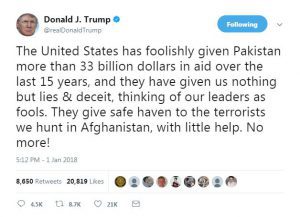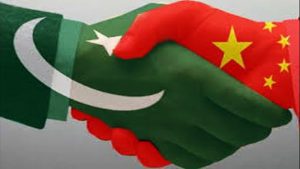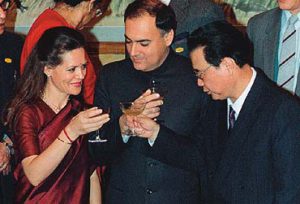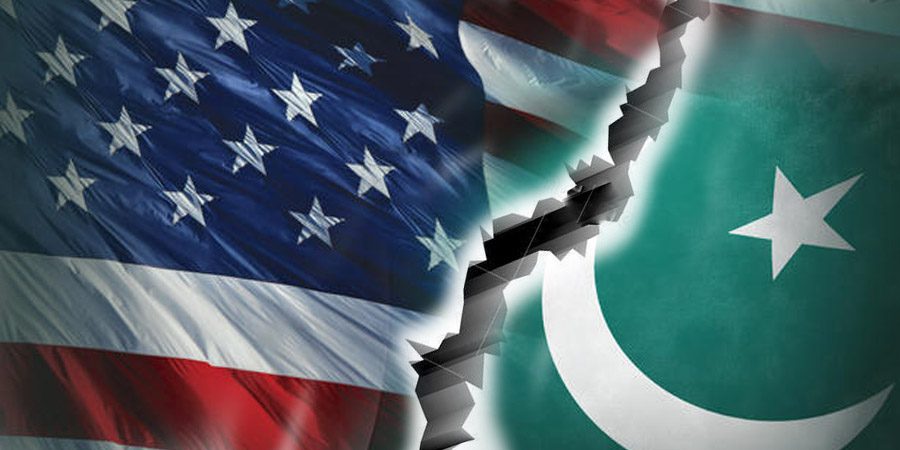Reading Time: 5 minutes
Can we draw linkages between the announcement by Trump and the subsequent announcement by Pakistan’s central bank the State Bank of Pakistan that all arrangements for using Chinese yuan for bilateral trade as well as financing investment activity between Pakistan and China are in place? Will Pakistan cozy up to the world’s second-largest economy? Our Associate Editor, Navodita, analyses the fissures in the US-Pak relations and its ramifications in South Asian geopolitics, in the weekly column. A Different Truths Exclusive.
The New Year tweet of President Donald Trump lambasting Pakistan has drawn an angry response on the streets and an official summoning of the U.S. ambassador in Islamabad to demand an explanation. He tweeted, “The United States has foolishly given Pakistan more than 33 billion dollars in aid over the last 15 years, and they have given us nothing but lies and deceit, thinking of our leaders as fools. They give safe haven to the terrorists we hunt in Afghanistan, with little help. No more!”
This statement by President Trump left one wondering whether there is going to be a shift in the U.S. policy regarding the Asian nation. A Pakistani journalist Khurram Husain says the sudden and  accelerating rupture in ties is coming at a time when the political and economic situations are both fragile. The debate in Pakistan, he goes on to say, has been understandably heated, with a lot of people asking what this means and how much the US aid actually matters for Pakistan. The question is: can we draw linkages between the announcement by Trump and the subsequent announcement by Pakistan’s central bank the State Bank of Pakistan that all arrangements for using Chinese yuan for bilateral trade as well as financing investment activity between Pakistan and China are in place. Will Pakistan cozy up to the world’s second-largest economy?
accelerating rupture in ties is coming at a time when the political and economic situations are both fragile. The debate in Pakistan, he goes on to say, has been understandably heated, with a lot of people asking what this means and how much the US aid actually matters for Pakistan. The question is: can we draw linkages between the announcement by Trump and the subsequent announcement by Pakistan’s central bank the State Bank of Pakistan that all arrangements for using Chinese yuan for bilateral trade as well as financing investment activity between Pakistan and China are in place. Will Pakistan cozy up to the world’s second-largest economy?
A statement issued by the SBP said, “The SBP, in the capacity of the policymaker of financial and currency markets, has taken comprehensive policy related measures to ensure that imports, exports, and financing transactions can be denominated in yuan.”
It may be said that Pakistan-China friendship dates back to the 1960s when the relationship of China with the Soviet Russia and India was souring. While Sino-India relationship languished in border skirmishes in October-November 1962, China got closer to Pakistan after the 1965 Indo-Pak conflict. The events of 1971 disappointed Chinese leadership with Pakistan’s handling of the 1971 political crisis. In January 1972, following his remarks welcoming Zulfikar Ali Bhutto, who went to Beijing after taking over as  president, Premier Zhou Enlai, addressing the Pakistani press, publicly stated that Chinese did not ‘provide arms (to a country) to be used against its own people’. Later in the year, China took the difficult decision to exercise its first ever veto to block Bangladesh’s admission to the United Nations (UN) and tied it to the return of Pakistani POWs. The Chinese veto proved critical in helping Pakistan to obtain the release of its POWs; it also defined the extent to which China could go in standing by Pakistan in a situation of crisis. The important nuance was evident in Premier Zhou’s reaction to Prime Minister Bhutto’s proposal for a defence pact between the two countries in 1974.
president, Premier Zhou Enlai, addressing the Pakistani press, publicly stated that Chinese did not ‘provide arms (to a country) to be used against its own people’. Later in the year, China took the difficult decision to exercise its first ever veto to block Bangladesh’s admission to the United Nations (UN) and tied it to the return of Pakistani POWs. The Chinese veto proved critical in helping Pakistan to obtain the release of its POWs; it also defined the extent to which China could go in standing by Pakistan in a situation of crisis. The important nuance was evident in Premier Zhou’s reaction to Prime Minister Bhutto’s proposal for a defence pact between the two countries in 1974.
The situation began changing in the post-Mao period with China reorienting its policies towards ‘four modernisations’, a dramatic opening to the West, and phenomenal economic growth led by Deng Xiaoping. In the 1960s and 1970s, China valued the importance of relations with Pakistan, which provided it with relief in the virtual cordon of hostile borders with most of its neighbours, as well as convenient access to the Middle East and Africa. From a full backing of Pakistan’s position based on the UN resolutions and self-determination for the people of Kashmir until the mid-1970s, China changed to respect the wishes of the Kashmiri people and then, by the 1990s, to support the bilateral efforts of Pakistan and India for a peaceful settlement. In 1996, President Jiang Zemin advised Pakistan to focus on economic development. Meanwhile, Sino-Indian relations had undergone a change and China had developed sensitivity to an emphasis on self-determination and needed to reconcile its positions with its concerns over separatist tendencies relating to Taiwan, Tibet, and Xinjiang.
The first upturn in Sino-Indian relations came during Rajiv Gandhi’s visit in 1988 when the two countries renounced the use of force and agreed to cooperate in fields of economy, trade and science and  technology. The second break came during the 2003 visit under Atal Behari Vajpayee when India for the first time accepted Tibet in a formal joint communiqué as an integral part of the People’s Republic of China and agreed to open a border crossing between Tibet and Sikkim for trade. Both developments led to accelerated growth of economic relations between the two largest Asian neighbours.
technology. The second break came during the 2003 visit under Atal Behari Vajpayee when India for the first time accepted Tibet in a formal joint communiqué as an integral part of the People’s Republic of China and agreed to open a border crossing between Tibet and Sikkim for trade. Both developments led to accelerated growth of economic relations between the two largest Asian neighbours.
In the present times, the absence of a clash of interests and any outstanding issues is a vital point of strength of Sino-Pakistan bilateral relations. The attacks on Chinese engineers in Gwadar in 2004 and subsequent incidents of kidnappings and killings of Chinese nationals came as a shock to both the Chinese government and its public, and questions were raised openly about the safety of Chinese workers in Pakistan. Gwadar port features prominently in the China-Pakistan Economic Corridor (CPEC) plan and is considered a link between One Belt, One Road, and Maritime Silk Road projects. The security situation in Pakistan is thus proving to be the biggest hurdle in attracting investments in Pakistan, in addition to other factors such as corruption and lack of facilities.
While Sino-Pakistan relations have continued to grow on a sound political foundation and a unique  convergence of geo-strategic interests, the realisation of their full potential will depend on Pakistan’s ability to engage with China in commerce, economic enterprise, and trade. Moreover, China views Pakistan as a potential ally against India, which it views as a potential rival. Even soft power and media in both China and Pakistan work to promote a favourable opinion for each other among the masses in both the countries. India needs to maintain her ‘soft power’ as a growing South Asian power and give a befitting reply to Pakistan and China. The Trump tweet is also being viewed by some in the Pakistani media as ‘the US getting closer to India’ under Modi regime. India needs to be equally mindful of China.
convergence of geo-strategic interests, the realisation of their full potential will depend on Pakistan’s ability to engage with China in commerce, economic enterprise, and trade. Moreover, China views Pakistan as a potential ally against India, which it views as a potential rival. Even soft power and media in both China and Pakistan work to promote a favourable opinion for each other among the masses in both the countries. India needs to maintain her ‘soft power’ as a growing South Asian power and give a befitting reply to Pakistan and China. The Trump tweet is also being viewed by some in the Pakistani media as ‘the US getting closer to India’ under Modi regime. India needs to be equally mindful of China.
©Navodita Pande
Photos from the Internet
#InternationalRelationship #TweetsOfTrump #PakistanAndUSARift #ChinaAndPakistan #IndiaAndChinaRelationship #ModiRegime #GlobalGanter


















